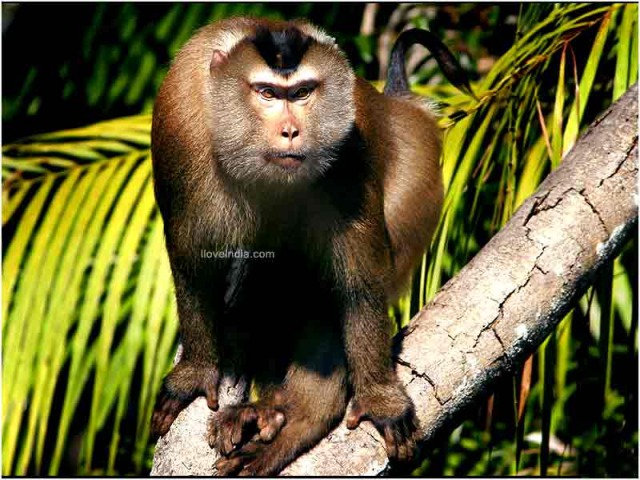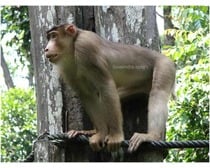The pig-tailed macaque is a threatened species, which tends to be quieter than the other macaque species. Explore some interesting facts and amazing information on pigtailed macaques.
Facts About Pig-Tailed Macaque
The pig-tailed macaque is a medium-sized primate, mostly found in the forests. However, it is also probable for these macaques to enter plantations and gardens. It has been named pig-tailed for its short tail that keeps curling on its back, which resembles the tail of a pig. While these macaques are omnivorous animals, fruits make around 80% of their diet. Pigtailed macaques remain quieter than the other macaque species. They often sleep on trees at night, for the fear of predators. Pig-tailed macaques roam in small subgroups in search of food, which they do basically to avoid confrontation at feeding sites. Researches on this macaque species have found them to be highly intelligent and mischievous. The canine teeth of male pig-tailed macaques are longer than those of females and measure up to 12 mm, on an average. If you want to know more about pig-tailed macaques, then read and come across some more interesting facts and amazing information.

Fast Facts
Kingdom: Animalia
Phylum: Chordata
Class: Mammalia
Order: Primates
Family: Cercopithecidae
Genus: Macaca
Species: M. nemestrina
Height: 1.5 to 2 ft.
Weight: 10 to 30 lbs.
Lifespan: Over 26 years
Diet: Leaves, roots, sprouts, mushrooms, fruit and invertebrates
Habitat: Lowland, coastal, swamp, dry and mountain forest up to 1700m.
Age of Sexual Maturity: 4 years
Gestation Period: 162-186 days
Number of Offspring: One every alternate year
Interesting & Amazing Information About Pig-Tailed Macaque
-
The pig-tailed macaque can be divided into two macaque sister species namely, the northern pigtailed macaque species and southern pig-tailed macaque species.
-
Pig-tailed macaques can be recognized by their olive-brown fur and white underpants. Their tail is short and slightly curled which is slender in shape, and can be thinly-furred or completely naked. The males have a larger body than the females.
-
The northern pig-tailed macaque, also known as macaca leonine is mostly seen in Southeastern Asia. They inhabit the forested areas of countries such as Burma, Indonesia, Laos, Thailand, India and Vietnam. The southern pig-tailed macaque also known as macaca nemestrina are found in Malay Peninsula, Borneo, and Sumatra.
-
The pig-tailed macaque is a threatened species, with only 900,000 such macaques left in the world. Their decline can be attributed to many factors, including heavy logging of the forests they inhabit, their hunting for meat, capturing for pet trade, and so on. They are also used in medicinal and cosmetic laboratory experiments.
-
The mating of this macaque species depends on the choice of the female. When a female macaque attains sexual maturity at the age of four, she is approached by the male macaques of the troop. However, she herself chooses her mate for breeding. The mother macaques are very protective of their babies and carry them wherever they go.
-
The groups in which these macaques hang out can be multi-male and multi-female. The male-female ratio can being 1 male to 5-8 females. The troop is headed by the females. The older male macaques lead solitary lives. They are diurnal animals and manage their time between the ground when at home and in the trees when out.
-
These macaques often divide themselves into foraging groups, due to their large group size. This is done to decrease direct competition for fruits at the sites of feeding. As such, they travel in small subgroups, keeping in touch with other subgroups through vocalizations. Pig-tailed macaques cover large areas each day, in search of food. Weather conditions and fruit availability are factors that determine their day range.
-
Pig-tailed macaques are trained for three-six months at a special school in Thailand, to work on coconut plantations. They retrieve coconuts from the trees and are capable of picking 800-1000 coconuts per day.
-
Macaques have been used in scientific laboratories for research on HIV. Recently a report offering a detailed study on the ecology and behavior of macaques was published.
-
In Thailand some hybrid pig-tailed macaques are found but, the interbreeding of two different species of macaques is not that common.


See also
More from iloveindia.com
- Home Remedies | Ayurveda | Vastu | Yoga | Feng Shui | Tattoos | Fitness | Garden | Nutrition | Parenting | Bikes | Cars | Baby Care | Indian Weddings | Festivals | Party ideas | Horoscope 2015 | Pets | Finance | Figures of Speech | Hotels in India : Delhi | Hyderabad | Chennai | Mumbai | Kolkata | Bangalore | Ahmedabad | Jaipur
- Contact Us Careers Disclaimer Privacy Policy Advertise With Us Lifestyle Sitemap Copyright iloveindia.com. All Rights Reserved.





